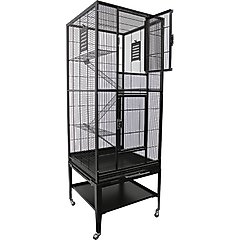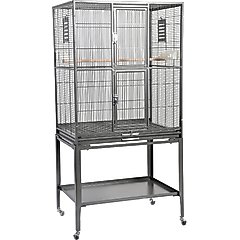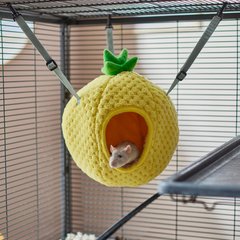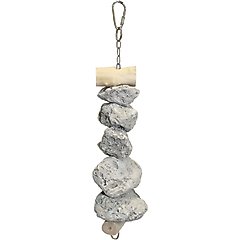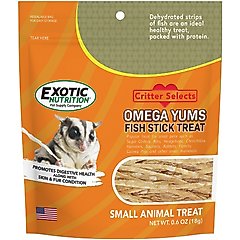8 Things To Know About Keeping Sugar Gliders as Pets
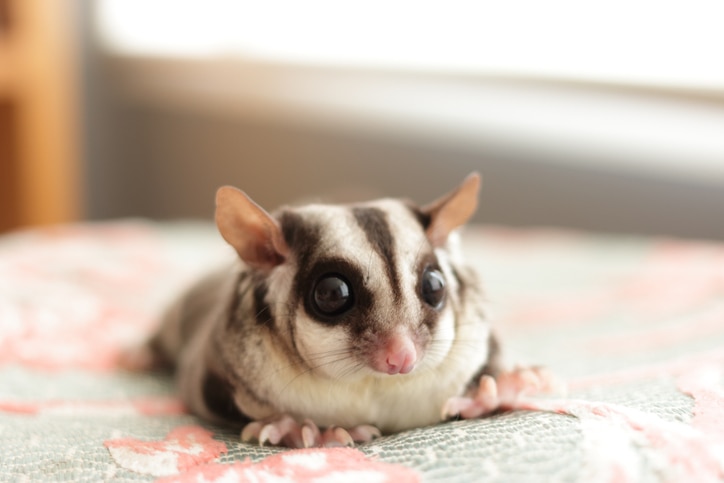
Photo by sevendeman/iStock/Getty Images Plus
With their cartoonishly oversized eyes, fuzzy little bodies, and playful personalities, sugar gliders may seem like the perfect pets.
However, these cute companions are exotic animals. They’re meant to be wild marsupials—native to Australia, Indonesia, and Papua New Guinea—and they have unique needs when it comes to their care.
So, are sugar gliders good pets? Not exactly, but there might be exceptions for those being rehomed.
Here’s everything you need to know about keeping sugar gliders as pets, including a few questions to start.
Key Takeaways
- Sugar gliders are exotic animals who need specialized care, so they don’t make great pets.
- Sugar gliders are wild animals native to Australia, Indonesia, and Papua New Guinea; it’s impossible to re-create their wild habitat in captivity.
- Many sugar gliders are rehomed at some point; if you’re going to bring home sugar gliders, adopt, don’t shop.
- It’s not legal to have a sugar glider in many states and cities, so do your research first.
- Sugar gliders need buddies: It’s ideal to have six to eight sugar gliders housed together, but at least two is a must.
3 Questions To Ask Before Getting a Sugar Glider
Before adopting a sugar glider, consider these three questions:
Is It Legal to Have a Sugar Glider?
In the U.S., laws vary from state to state, and even between cities. In some states, including Hawaii, Alaska, and California, it’s illegal to keep a sugar glider as a pet.
Other states, such as Pennsylvania, require a special permit. While legal in most of New York state, sugar gliders as pets are a no-no in New York City. If you’re interested in becoming a sugar glider pet parent, check with your state’s fish and wildlife department, as well as local government, to see what the rules are.
Are You Really Ready To Adopt a Sugar Glider?
Sugar gliders are nocturnal wild animals who require specialized housing, diets, and social networks.
“Generally speaking, sugar gliders don’t make great pets,” says Alea Holladay, founder of Sugar Glider Guardians, a Houston nonprofit that educates sugar glider pet parents and often rehomes these exotic creatures. Like many people with sugar gliders, Holladay bought her first one at a festival and wasn’t prepared for the time and commitment they require.
“People buy them because they’re cute, but they can live up to 15 years, and caring for them is a big commitment,” she says. In fact, she started Sugar Glider Guardians because she saw so many sugar gliders who were “just going from bad home to bad home.”
Is It Ethical To Adopt a Sugar Glider?
In the wild, sugar gliders live in colonies and spend their nights gliding through the treetops and snacking on nectar and insects. This environment is near impossible to replicate in captivity.
“Their needs are very difficult and very expensive to meet,” says Dr. Cathy Johnson-Delaney, DVM, a veterinarian in Mukilteo, Washington, who is board-certified in avian and exotic companion animal medicine. “They’re highly active, highly social, they need lots of space to run and jump, and they’re nocturnal.”
“On the internet, sugar gliders are promoted as cute pets, with names like ‘honey bears,’” adds Dr. Johnson-Delaney, who studied wild sugar gliders in Australia. “But they’re wild animals, and unless you’re ready to create Australia North in your home, it’s not going to be a good life.”
8 Things To Know Before Bringing Home a Sugar Glider
It’s never a good idea to purchase a sugar glider, experts agree. However, if you choose to take in sugar gliders in need of rehoming, here’s what to know to give them the best care.
Sugar Gliders Are Night Owls
As nocturnal animals, sugar gliders spend their days sleeping, and their nights playing, socializing, and eating. Their natural sleep cycle should not be disrupted, so if you don’t plan to be awake at night, a sugar glider might not be your spirit animal.
“One of the biggest mistakes people make is trying to make sugar gliders daytime pets,” says Dr. Johnson-Delaney. “You can’t—they’re wild animals. They spend their nights screaming and yelling and playing, and in the morning, there’s a lot of cleaning up to do.”
They Need a Friend
As social animals who live in colonies, sugar gliders must be housed with other sugar gliders. When living alone, sugar gliders become depressed and can exhibit signs of stress, including harming themselves.
“You cannot have a single sugar glider and not have it clinically depressed,” says Dr. Johnson-Delaney.
Ideally, captive sugar gliders should live with at least six to eight other gliders, she adds. However, even one sugar glider buddy can make all the difference for your pet, and it’s never too late to find them a companion.
“Introductions should be slow and steady,” Holladay says. “It can be difficult if they’ve been alone their whole life, but it’s essential.”
They Need a Special Vet
Not all veterinarians have experience with sugar gliders. Before adopting, have an exotic vet on standby. The Association of Exotic Mammal Veterinarians maintains a directory of veterinarians who treat exotic animals, including sugar gliders.
Sugar Gliders Need a Very Large ‘House’
Most habitats intended for sugar gliders are far too small, according to Holladay and Dr. Johnson-Delaney. When shopping for a sugar glider enclosure, look for the largest one available.
“The bigger the better—you want it huge,” Holladay says.
Recommended Products
Equip their enclosure with lots of hiding places and enrichment toys.
Recommended Products
It’s also important that your gliders explore other parts of the home, so have additional spaces, such as a bathroom, set up for supervised playtime.
The Typical Sugar Glider Lifespan Is Longer Than a Dog’s
Because they’re about the same size as hamsters, many people assume sugar gliders have similarly short lifespans. However, these exotic cuties can live up to 15 years in captivity.
They Need Your Attention
Sugar gliders need glider friends, but they also need to bond and socialize with their human buddy.
“If you don’t interact with your gliders, they will be afraid to come out of the cage and will become stressed,” says Holladay. “They’re smart and playful, so there are plenty of ways to engage.”
Sugar glider owners need to set aside time at night to interact with their pets. Holladay suggests the following activities:
- Hide treats in plastic Easter eggs or pill boxes, and let your gliders “hunt” for their snacks
- Set up a popup tent in another room and let them play in a new area
- Tie small twigs into knots and let your gliders untie them (a favorite sugar glider activity)
- Let crickets loose in the bathroom for (supervised) hunting
- Offer fresh eucalyptus branches for a tasty snack that’s fun to carry (gliders enjoy carrying things by their tails)
Recommended Products
They Have a Very Specific Diet
Providing a healthy, nutritionally balanced diet is one of the most challenging parts of caring for sugar gliders. In the wild, sugar gliders are omnivorous, feeding on plant secretions (such as sap, gum, nectar, and pollen) and insects.
“To do a glider diet correctly is complicated, and most people can’t manage it,” says Dr. Johnson-Delaney. “We have a lot of gliders who are surrendered and don’t make it, because their diets are awful.”
Commercial pellet diets are available for pet sugar gliders. However, the gold standard is a fresh food diet of vegetables, fruits, and insects, supplemented by Wombaroo High Protein Supplement, which provides essential amino acids, vitamins, calcium, and minerals.
“Wombaroo is made in Australia, and it’s the best high-protein supplement on the market for sugar gliders,” says Dr. Johnson-Delaney. “You can follow the diet right on the box.”
Diets with too much fruit or added honey can cause obesity and tooth decay; both health issues are common in pet sugar gliders, notes Holladay.
They Are Easily Stressed Out
Without proper socialization, enrichment, and care, sugar gliders become stressed in captivity. Symptoms of stress in sugar gliders include:
- Overgrooming
- Excessive vocalization
- Self-harming
- Pacing
- Biting
A sugar glider—especially a stressed one—may bite, so it’s important to learn how to handle your gliders properly to avoid injury. One of the best ways is to watch experts interact with their sugar gliders until you feel comfortable handling yours.
If you’re able to adopt at least two sugar gliders with nowhere to go, they’ll be unique, curious companions—and you’ll be a hero for helping animals in need.
Hamsters and guinea pigs are excellent options for pet parents who’d like a slightly less high-maintenance small pet.
FAQs About Sugar Gliders as Pets
Can you adopt a sugar glider?
Yes, sugar gliders are available for adoption. Many people seek to rehome their sugar gliders because they didn’t realize they have long lifespans with high-maintenance care. If you are certain you can meet the needs of at least two sugar gliders, there are many at exotic animal rescues waiting for forever homes. Never purchase a sugar glider.
Can sugar gliders fly?
Sugar gliders cannot technically fly. Instead, they glide through the air using a thin membrane of skin that stretches between their wrists and ankles, similar to a flying squirrel.
